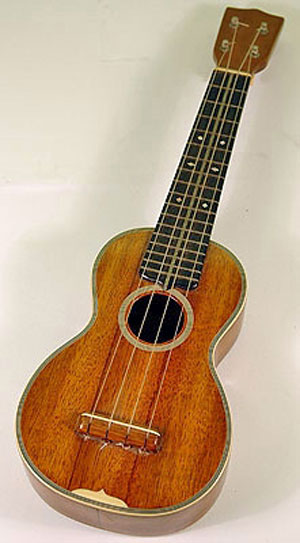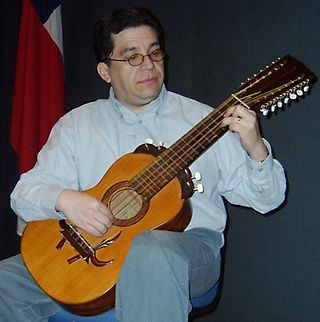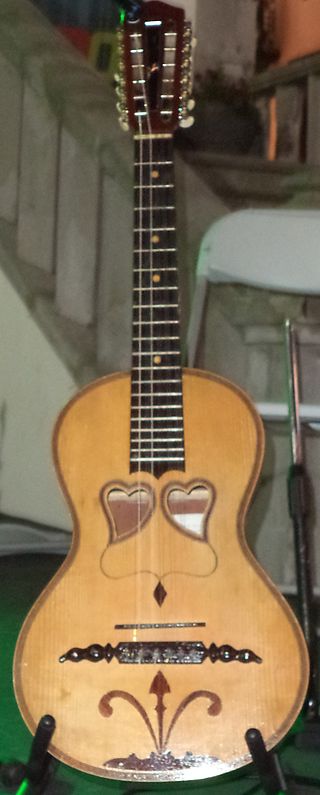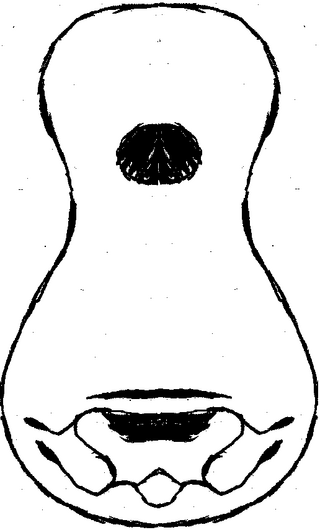Related Research Articles
A mandolin is a stringed musical instrument in the lute family and is generally plucked with a pick. It most commonly has four courses of doubled strings tuned in unison, thus giving a total of eight strings. A variety of string types are used, with steel strings being the most common and usually the least expensive. The courses are typically tuned in an interval of perfect fifths, with the same tuning as a violin. Also, like the violin, it is the soprano member of a family that includes the mandola, octave mandolin, mandocello and mandobass.

The Appalachian dulcimer is a fretted string instrument of the zither family, typically with three or four strings, originally played in the Appalachian region of the United States. The body extends the length of the fingerboard, and its fretting is generally diatonic.

The seven-string guitar adds one additional string to the more common six-string guitar, commonly used to extend the bass range or also to extend the treble range.

D A D G A D, or Celtic tuning, is an alternative guitar tuning most associated with Celtic music, though it has also found use in rock, folk, metal and several other genres. Instead of the standard tuning the six guitar strings are tuned, from low to high, D2A2D3G3A3D4.
The term requinto is used in both Spanish and Portuguese to mean a smaller, higher-pitched version of another instrument. Thus, there are requinto guitars, drums, and several wind instruments.

A tiple, is a plucked typically 12-string chordophone of the guitar family. A tiple player is called a tiplista. The first mention of the tiple comes from musicologist Pablo Minguet e Irol in 1752. Although many variations of the instrument exist, the tiple is mostly associated with Colombia, and is considered the national instrument. The Puerto Rican version characteristically has fewer strings, as do variants from Cuba, Mallorca, and elsewhere among countries of Hispanic origin.
In music, standard tuning refers to the typical tuning of a string instrument. This notion is contrary to that of scordatura, i.e. an alternate tuning designated to modify either the timbre or technical capabilities of the desired instrument.
The cuatro is a family of Latin American string instruments played in Colombia, Puerto Rico, Venezuela and other Latin American countries. It is derived from the Spanish guitar. Although some have viola-like shapes, most cuatros resemble a small to mid-sized classical guitar. In Puerto Rico and Venezuela, the cuatro is an ensemble instrument for secular and religious music, and is played at parties and traditional gatherings.

A classical guitar with additional strings is a nylon-string or gut-string classical guitar with more than six strings, in which the additional strings pass over a fingerboard so that they may be "stopped" or fretted with the fingers. These are also known as extended-range guitars, and should not be confused with harp guitars.

On a stringed instrument, a break in an otherwise ascending order of string pitches is known as a re-entry. A re-entrant tuning, therefore, is a tuning which does not order all the strings from the lowest pitch to the highest pitch.

Laúd is a plectrum-plucked chordophone from Spain, played also in diaspora countries such as Cuba and the Philippines.
The octophone is a stringed musical instrument related to the mandola family resembling an octave mandolin. It was marketed by Regal Musical Instrument Company, who introduced it 21 January 1928, as an "eight-purpose instrument".

The Guitarrón Chileno is a guitar-shaped plucked string instrument from Chile, with 25, 24 (rarely), or even 26 strings. Its primary contemporary use is as the instrumental accompaniment for the traditional Chilean genre of singing poetry known as Canto a lo Poeta, though a few virtuosi have also begun to develop the instrument's solo possibilities.

The Guitolão is a chordophone designed by Portuguese luthier Gilberto Grácio. It is a baritone version of the Portuguese guitar.
The Guitarra de golpe is a stringed musical instrument from Mexico. It has 5 nylon strings in 5 courses. The headstock traditionally has a traditional shape that is designed to look like a stylised owl with wooden pegs, but nowadays this is sometimes replaced with a guitar or vihuela style headstock with machine heads. For a while during the 20th century, the Guitarra De Golpe fell into disuse in traditional Mariachi groups, and was replaced by the Classical guitar. It has now however been revived. It is still an essential part of the "conjuntos de arpa" from Michoacán.

The viola beiroa is a stringed musical instrument from Castelo Branco, Eastern Portugal. It has 12 strings in 7 courses. The strings are made of steel. It is tuned D3, D3, A3 A2, D3 D2, G3 G2, B3 B3, D3 D3. The scale length is about 520mm.

Viola da terra is a stringed musical instrument from the islands of the Azores, closely associated with the saudade genre of Portuguese music. Its 12 or 15 metal strings are arranged in either five or six courses.

The viola toeira is a stringed musical instrument from Portugal. It has 12 strings in five courses. The strings are made of steel. It is tuned A3 A3 A2, D3 D3 D2, G3 G2, B3 B3, E3 E3.
The viola sertaneja is a stringed musical instrument from northeastern Brazil. It has 10 strings in 5 courses. The strings are made of steel. It is tuned E2, A3, D4, G4, B3, E4 E4 E4.

The Algerian mandole is a steel-string fretted instrument resembling an elongated mandolin, widely used in Algerian music such as Chaabi, Kabyle music and Nuubaat.
References
Notes
- 1 2 3 4 José Wellington do Nascimento (2012), p.18
- ↑ Gaspar Frutuoso (2005), p.120-127
- 1 2 3 4 5 6 Almeida, José Lúcio Ribeiro de (19 July 2016), "Viola da Terceira", Instrumentos Populares Portugueses (PDF) (in Portuguese), Lisbon, Portugal, p. 11
{{citation}}: CS1 maint: location missing publisher (link) - 1 2 3 4 José Wellington do Nascimento (2012), p.19
- ↑ "18-string Viola da Terciera
- ↑ "ATLAS of Plucked Instruments - Europe West". Atlasofpluckedinstruments.com. Retrieved 20 April 2021.
Sources
- Frutuoso, Gaspar (2005), Saudades da terra. rev. do texto e reformulação de índices Jerónimo Cabral (in Portuguese), Ponta Delgada (Azores), Portugal: Instituto Cultural of Terceira
- Nascimento, José Wellington do (2012), Viola da Terra, Património e Identidade Açoriana (in Portuguese), Ponta Delgada (Azores), Portugal: University of the Azores
- The Stringed Instrument Database
- ATLAS of Plucked Instruments